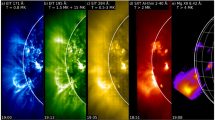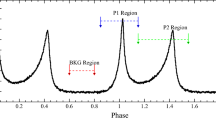Abstract
An investigation into Type II solar radio bursts was carried out to understand the frequency gap between fundamental and harmonic emissions of the radio burst. This investigation focused on Type II solar radio bursts with flares and coronal mass ejections by relating the separation between fundamental and harmonic emissions. We used the Compound Astronomical Low-cost Low-frequency Instrument for Spectroscopy and Transportable Spectrometers (CALLISTO) and a newly designed low-frequency antenna array. This article describes the proposed new instrument in terms of its antenna design, the bandpass testing of the antenna, the new system significance in studying Type II solar radio bursts, and its comparison with other leading radio solar monitoring instruments. Upon setting up the new technology, the radio-frequency interference of the observation site at the University of Malaya was shown to emphasize the suitability of the selected site. This article also shows the preliminary results of the proposed new instrument by reporting the detection of a Type III solar radio burst that was confirmed by CALLISTO. Moreover, it also includes the optimal observation design and strategies for future detections.











Similar content being viewed by others
References
Abidin, Z.Z., Anim, N.M., Hamidi, Z.S., Monstein, C., Ibrahim, Z.A., Umar, R., Shariff, N.N.M., Ramli, N., Aziz, N.A.I., Sukma, I.: 2015, Radio frequency interference in solar monitoring using CALLISTO. New Astron. Rev.67, 18.
Aschwanden, M.J., Benz, A.O.: 1995, Chromospheric evaporation and decimetric radio emission in solar flares. Astrophys. J.438, 997.
Batubara, M., Manik, T., Suryana, R., Lathif, M., Sitompul, P., Zamzam, M., Mumtahana, F.: 2017, Frequency drift rate investigation of solar radio burst type II due to coronal mass ejections occurrence on 4th November 2015 captured by CALLISTO at Sumedang-Indonesia. In: Abdullah, A.G., Nandiyanto, A.B.D., Danuwijaya, A.A. (eds.) 1st Ann. App. Sci. Eng. Conf., Materials Sci. Eng.CS-180, 012048. IOP, Bristol. DOI
Bowman, J.D., Cairns, I., Kaplan, D.L., Murphy, T., Oberoi, D., Staveley-Smith, L., Arcus, W., Barnes, D.G., Bernardi, G., Briggs, F.H., et al.: 2013, Science with the Murchison Widefield Array. Publ. Astron. Soc. Aust.30, e031.
Chen, C., Wang, Y., Shen, C., Ye, P., Zhang, J., Wang, S.: 2011, Statistical study of coronal mass ejection source locations: 2. Role of active regions in CME production. J. Geophys. Res. Space Phys.116 A12108. DOI
Eselevich, V., Eselevich, M., Zimovets, I.: 2016, Possible reasons for the frequency splitting of the harmonics of type II solar radio bursts. Astron. Rep.60, 163.
Fitzpatrick, R.: 2014, Plasma Physics: An Introduction, CRC Press, Boca Raton. URL: http://farside.ph.utexas.edu/teaching/plasma/plasma.html
Gopalswamy, N.: 2016, History and development of coronal mass ejections as a key player in solar terrestrial relationship. Geosci. Lett.3, 8.
Gopalswamy, N., Thompson, W., Davila, J., Kaiser, M., Yashiro, S., Mäkelä, P., Michalek, G., Bougeret, J.-L., Howard, R.: 2009, Relation between type II bursts and CMES inferred from STEREO observations. Solar Phys.259, 227. DOI . ADS .
Gopalswamy, N., Xie, H., Mäkelä, P., Yashiro, S., Akiyama, S., Uddin, W., Srivastava, A., Joshi, N., Chandra, R., Manoharan, P., et al.: 2013, Height of shock formation in the solar corona inferred from observations of type II radio bursts and coronal mass ejections. Adv. Space Res.51, 1981.
Kishore, P., Ramesh, R., Hariharan, K., Kathiravan, C., Gopalswamy, N.: 2016, Constraining the solar coronal magnetic field strength using split-band type II radio burst observations. Astrophys. J.832, 59.
Kumar, A., Kumar, S.: 2014, Space weather effects on the low latitude d-region ionosphere during solar minimum. Earth Planets Space66, 76.
Marusek, J.A.: 2007, Solar storm threat analysis, Impact, Bloomfield, 2. URL: citeseerx.ist.psu.edu/viewdoc/download?doi=10.1.1.129.6527&rep=rep1&type=pdf
Monstein, C.: 2012, Catalogue of dynamic electromagnetic spectra observed with Callisto and Phoenix-3. Radio Astron. J. Soc. Amat. Radio Astron.7, 63.
Oberoi, D., Sharma, R., Rogers, A.E.: 2017, Estimating solar flux density at low radio frequencies using a sky brightness model. Solar Phys.292, 75. DOI . ADS .
Orfanidis, S.J.: 2002, Electromagnetic Waves and Antennas, Rutgers University, New Brunswick, 739.
Schnack, D.D.: 2009, Lectures in Magnetohydrodynamics: With an Appendix on Extended MHD, Lecture Notes in Physics780, Springer, Berlin-Heidelberg, 197.
Smerd, S., Sheridan, K., Stewart, R.: 1975, Split-band structure in type II radio bursts from the Sun. Astrophys. Lett.16, 23.
Vršnak, B., Lulić, S.: 2000, Formation of coronal MHD shock waves – I. The basic mechanism. Solar Phys.196, 157. DOI . ADS .
Winter, L., Ledbetter, K.: 2015, Type II and type III radio bursts and their correlation with solar energetic proton events. Astrophys. J.809, 105.
Yan, Y., Zhang, J., Wang, W., Liu, F., Chen, Z., Ji, G.: 2009, The Chinese spectral radioheliograph – CSRH. Earth Moon Planets104, 97.
Zimovets, I., Vilmer, N., Chian, A.-L., Sharykin, I., Struminsky, A.: 2012, Spatially resolved observations of a split-band coronal type II radio burst. Astron. Astrophys.547, A6.
Zucca, P., Carley, E., McCauley, J., Gallagher, P., Monstein, C., McAteer, R.: 2012, Observations of low frequency solar radio bursts from the Rosse Solar-Terrestrial Observatory. Solar Phys.280, 591. DOI . ADS .
Acknowledgments
This project was made possible through a close collaboration between YNAO and UM. The start of this project was made through an agreement via an official MOU signed between the two institutes on 5 May 2016. The authors would like to thank the CALLISTO network for making their data available online and hence for this project. We would like to express our sincere gratitude to the University of Malaya Observatory, especially Nazhatulshima Ahmad, for the permission and support to use their site for the antenna construction, testing, and observations. We would like to also acknowledge the Government of Malaysia’s FRGS grant (FP034-2013B) for the financial support that enabled us to conduct this project.
Author information
Authors and Affiliations
Corresponding author
Ethics declarations
Disclosure of Potential Conflicts of Interest
The authors declare that they have no conflicts of interest.
Additional information
Publisher’s Note
Springer Nature remains neutral with regard to jurisdictional claims in published maps and institutional affiliations.
Rights and permissions
About this article
Cite this article
Pauzi, F.A.M., Abidin, Z.Z., Guo, S.J. et al. Investigation into CME Shock Speed Resulting from Type II Solar Radio Bursts. Sol Phys 295, 42 (2020). https://doi.org/10.1007/s11207-019-1404-z
Received:
Accepted:
Published:
DOI: https://doi.org/10.1007/s11207-019-1404-z




